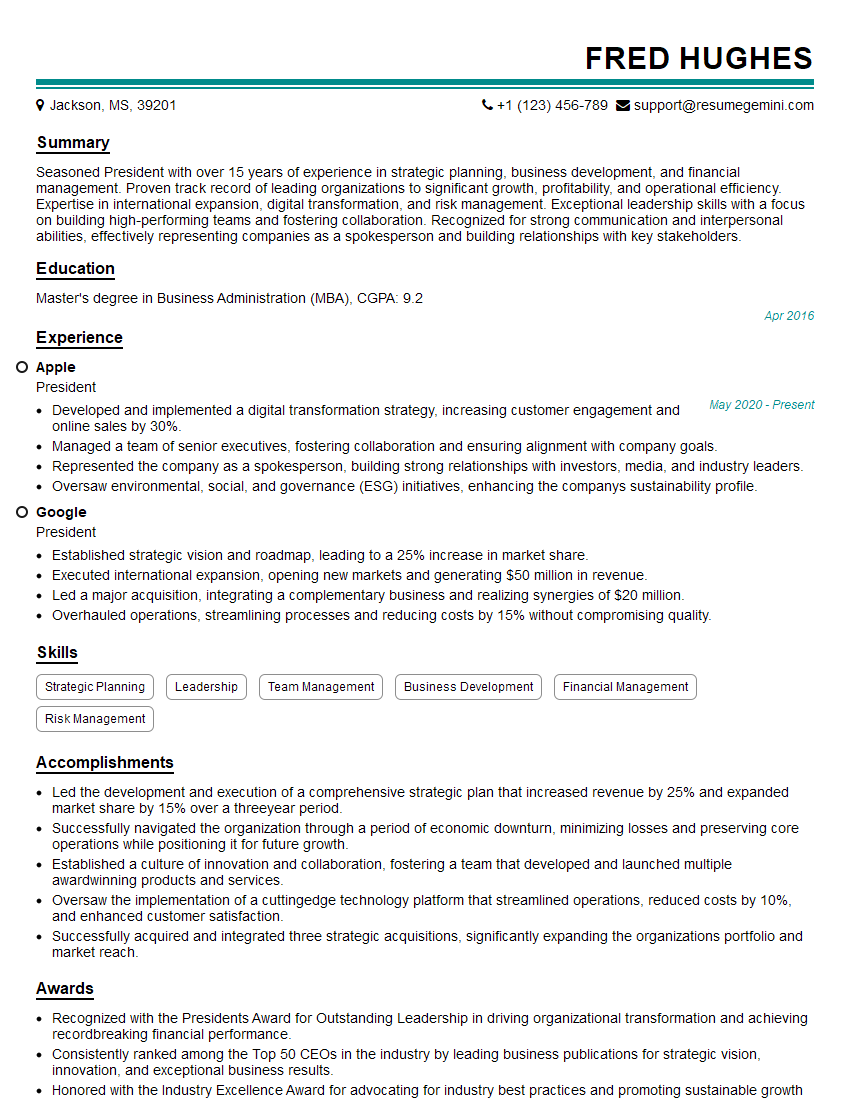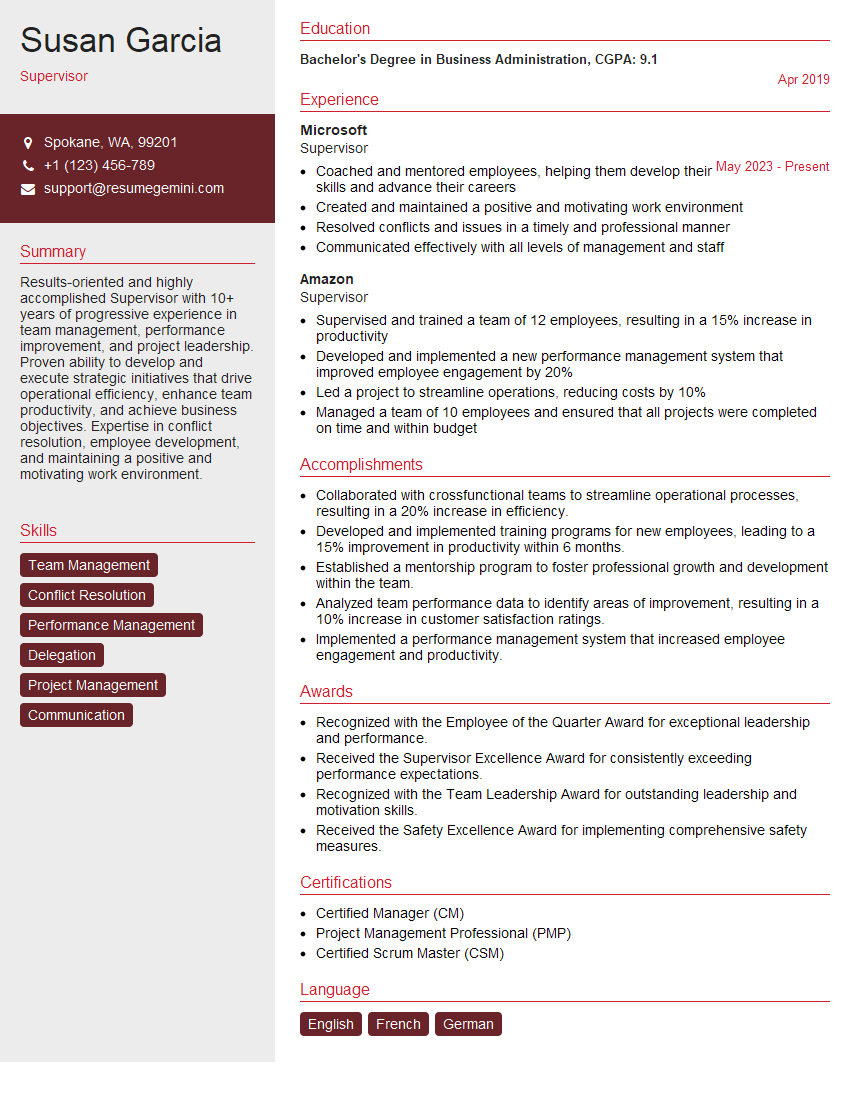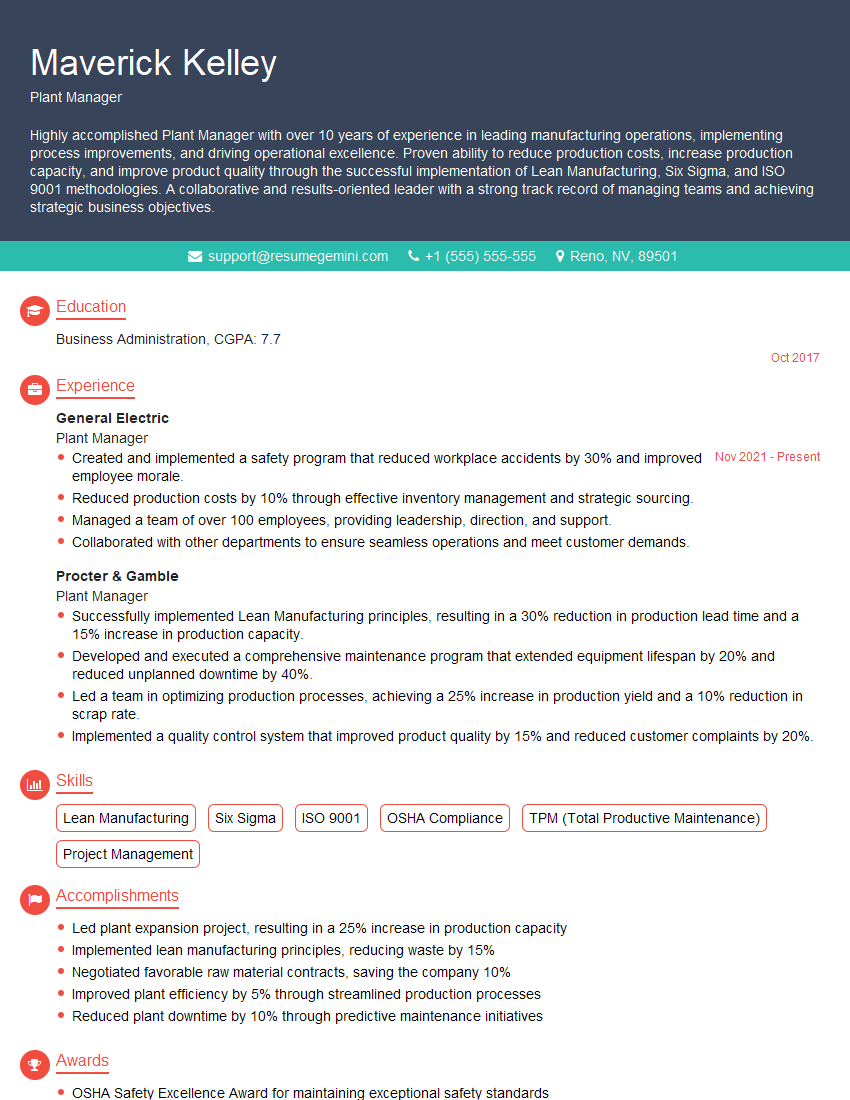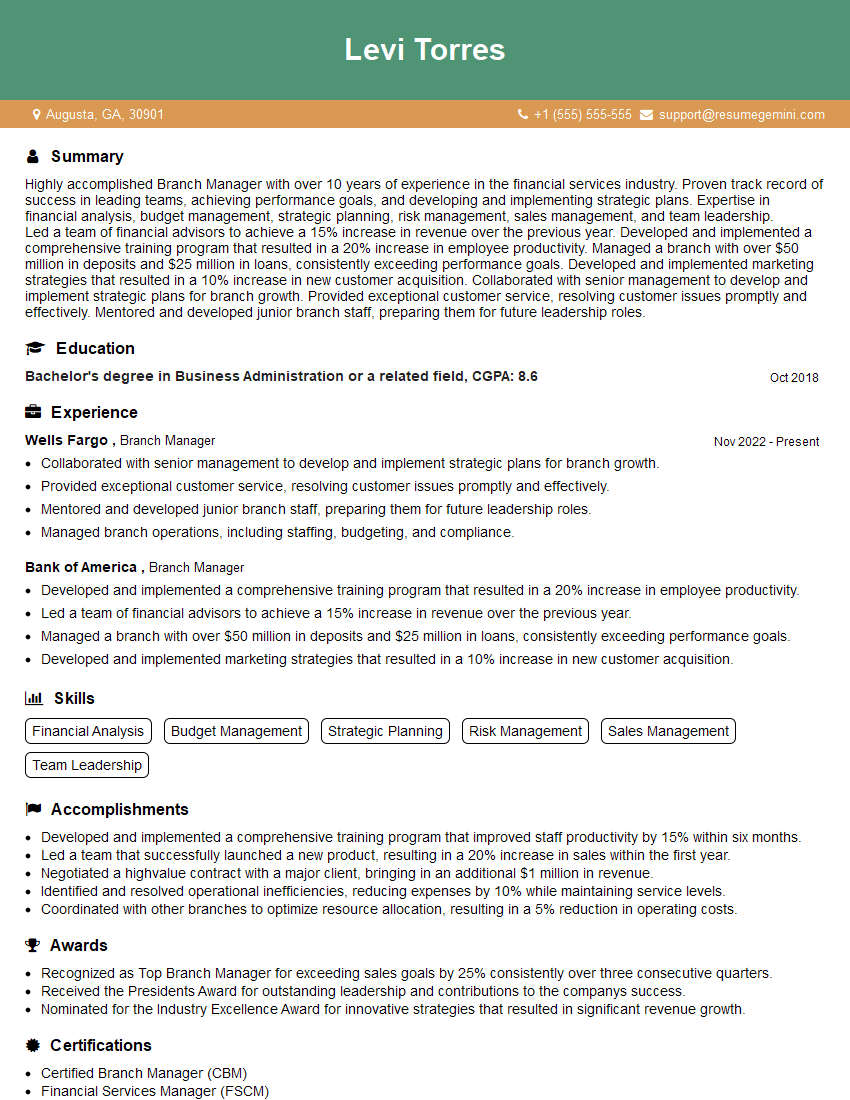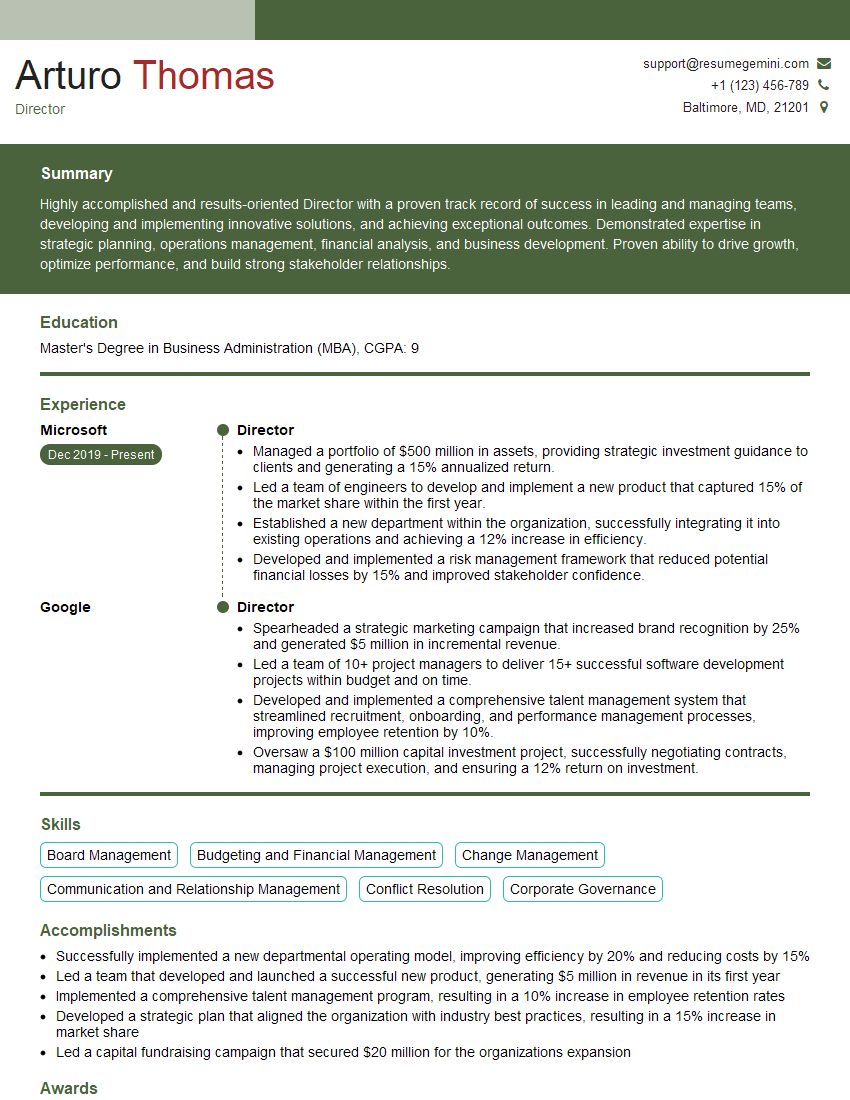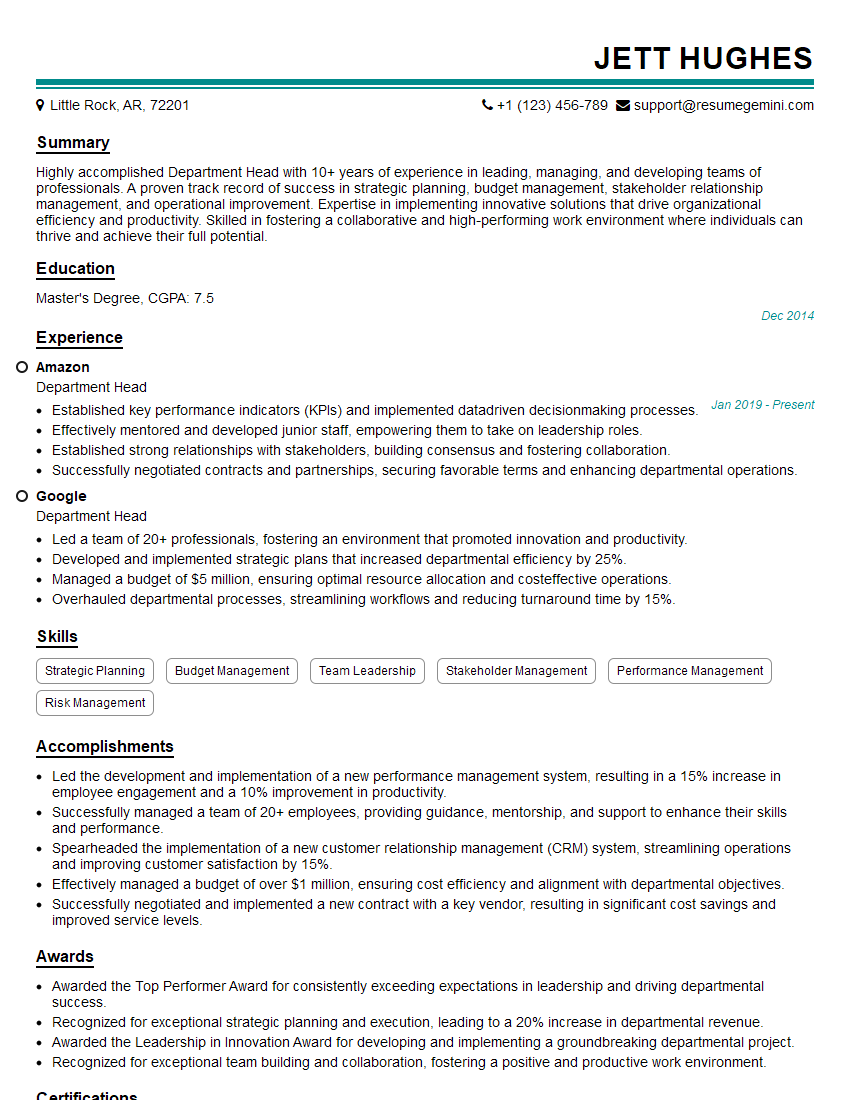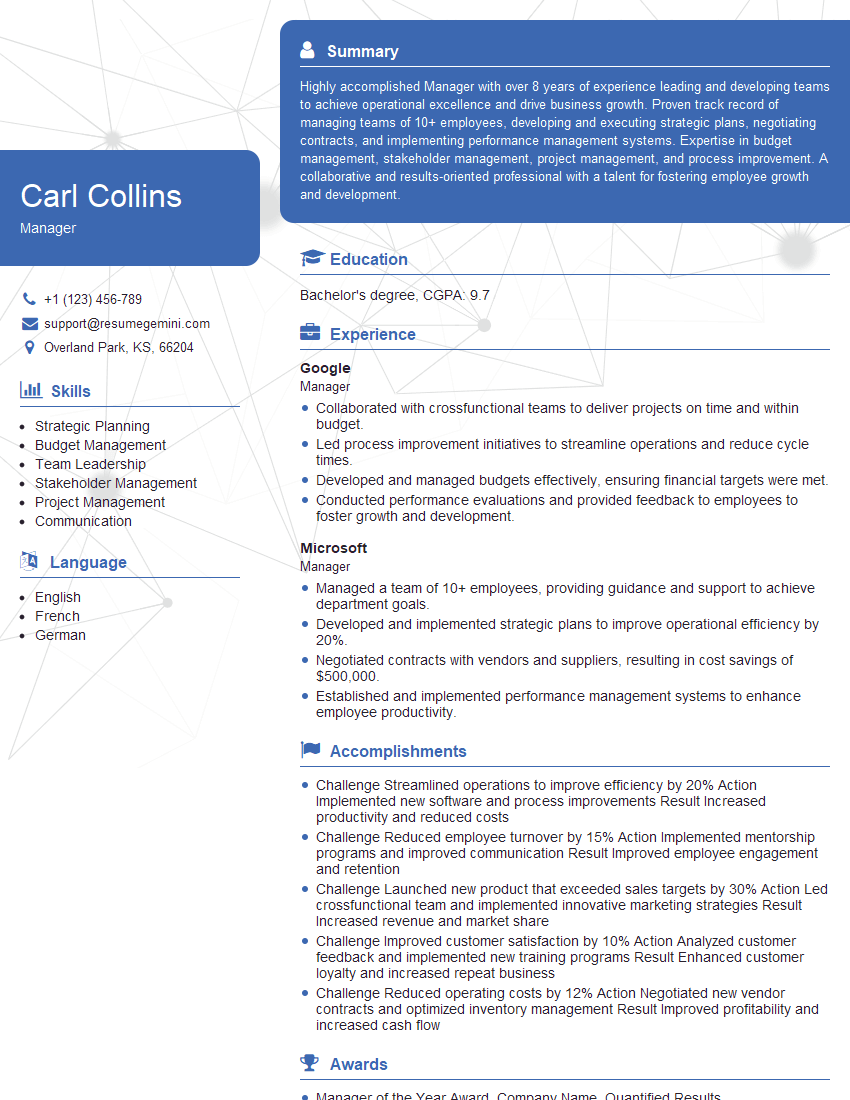Unlock your full potential by mastering the most common Leadership and Responsibility interview questions. This blog offers a deep dive into the critical topics, ensuring you’re not only prepared to answer but to excel. With these insights, you’ll approach your interview with clarity and confidence.
Questions Asked in Leadership and Responsibility Interview
Q 1. Describe your leadership style and how it adapts to different team dynamics.
My leadership style is best described as adaptable and collaborative. I believe in empowering my team members, fostering a sense of shared ownership and purpose. I don’t adhere to a rigid, one-size-fits-all approach. Instead, I assess the team’s dynamics – considering factors like individual strengths, communication styles, and experience levels – to tailor my leadership approach. For instance, with a highly experienced team comfortable with autonomy, I adopt a more delegative style, focusing on providing strategic guidance and support. Conversely, with a newer team needing more direction, I employ a more directive style, offering clear instructions, regular check-ins, and mentorship.
For example, in my previous role leading a software development team, one team was comprised of seasoned developers comfortable working independently. My approach involved setting clear goals, providing the necessary resources, and then stepping back, offering support only when needed. Another team, however, consisted of recent graduates, requiring more direct supervision, frequent feedback sessions, and training to improve their skills.
Q 2. How do you delegate tasks effectively and monitor progress?
Effective delegation involves identifying the right person for the task, clearly defining expectations, providing necessary resources, and establishing clear timelines and accountability. I don’t simply assign tasks; I invest time in explaining the ‘why’ behind each task, ensuring my team understands the bigger picture and their contribution’s significance. Monitoring progress involves regular check-ins, open communication channels, and utilizing project management tools to track progress against deadlines. I don’t micromanage; instead, I focus on providing support and addressing roadblocks.
In a previous project, I delegated the creation of a marketing campaign to a team member skilled in graphic design and marketing strategies. I provided detailed briefs outlining target audience, campaign goals, and timelines. We scheduled regular meetings to discuss progress, address challenges, and ensure alignment with the overall project goals. This collaborative approach ensured the project was completed successfully and on time.
Q 3. Explain a time you had to make a difficult decision under pressure.
During a critical product launch, a major software bug was discovered just days before the release date. The pressure was immense, as a delay could have significant financial repercussions. I had to make a rapid decision: proceed with the launch with a partial fix, causing some inconvenience, or delay the launch, incurring potential losses. After carefully assessing the risks and benefits of each option, considering the severity of the bug and the potential impact on user experience, I opted for a partial fix, prioritizing the launch date while addressing the most critical aspects of the bug. This involved clear communication with the team, prioritizing and assigning tasks swiftly, and deploying a hotfix. While there were minor issues reported post-launch, they were effectively mitigated through immediate updates. The decision, while difficult, resulted in minimizing losses and maintaining a positive company image.
Q 4. How do you handle conflict within a team?
Conflict is inevitable in any team. My approach involves fostering an environment of open communication and respect, where team members feel comfortable voicing their concerns. I actively listen to all sides, aiming to understand the root cause of the conflict, not just the symptoms. Once the underlying issues are identified, I facilitate a collaborative discussion, guiding the team toward a mutually acceptable solution. In some cases, mediation might be necessary. The goal is not to assign blame, but to resolve the conflict constructively, learning from it and strengthening the team’s dynamics.
For example, once I had a disagreement between two team members regarding project priorities. Instead of taking sides, I organized a meeting where they could openly express their concerns and perspectives. We then collaboratively prioritized tasks based on impact and urgency, using a prioritization matrix. This process not only resolved the immediate conflict but also improved the team’s understanding of project priorities.
Q 5. Describe your experience in motivating and mentoring team members.
Motivating and mentoring team members requires a personalized approach. I believe in recognizing individual strengths and tailoring my approach accordingly. This includes providing regular feedback, both positive reinforcement and constructive criticism, setting challenging yet achievable goals, and celebrating successes. Mentoring involves investing time in developing team members’ skills, providing guidance and support, and fostering their professional growth. I utilize various techniques such as one-on-one meetings, skill-building workshops, and shadowing opportunities. I also encourage continuous learning and professional development by providing access to training resources and opportunities for advancement.
I once mentored a junior team member who was struggling with a specific technical skill. By providing personalized coaching sessions, demonstrating practical applications, and providing constructive feedback on their projects, I helped them overcome their challenges and significantly improve their skillset. This ultimately boosted their confidence and contributed to their success within the team.
Q 6. How do you measure the success of a project or team?
Measuring the success of a project or team involves setting clear, measurable goals at the outset. This requires defining key performance indicators (KPIs) that align with overall business objectives. These KPIs can vary depending on the nature of the project, but may include metrics such as project completion rate, budget adherence, client satisfaction, or team productivity. Regular monitoring and analysis of these KPIs allow for timely adjustments and ensure the project or team remains on track. Post-project reviews provide further insights, allowing for lessons learned and improvements in future projects.
For instance, in a recent project, our KPIs included on-time delivery, adherence to budget, and client satisfaction measured by a post-project survey. Tracking these throughout the project enabled early detection of potential delays and allowed for corrective actions. The post-project review also revealed areas for improvement in our project management processes.
Q 7. How do you manage competing priorities and deadlines?
Managing competing priorities and deadlines requires a structured approach. I utilize project management methodologies like Agile or Kanban to prioritize tasks based on urgency and importance. This involves creating a prioritized task list, allocating resources effectively, and setting realistic deadlines. Regular communication with stakeholders is crucial to ensure alignment and address potential conflicts. Time management techniques, such as time blocking and prioritization matrices, also play a significant role in managing workload effectively. It is important to be proactive, anticipate potential delays, and communicate openly about any challenges.
In one instance, I faced simultaneous deadlines for multiple projects. To manage this, I created a prioritized task list using a matrix that considered urgency and impact. I then allocated team members based on their expertise and availability, ensuring each team member had a manageable workload. Regular status meetings kept everyone informed about the progress of each project and allowed for timely adjustments.
Q 8. How do you provide constructive feedback to team members?
Constructive feedback is a crucial leadership skill. It’s about offering guidance and support to help team members improve, not about criticism. My approach focuses on the SBI model: Situation, Behavior, Impact.
Situation: I clearly describe the specific situation where the behavior occurred. For instance, ‘During the recent project presentation…’
Behavior: I objectively describe the behavior, avoiding judgmental language. Instead of saying ‘You were disorganized,’ I might say, ‘The presentation lacked a clear structure, and some key data points were missing.’
Impact: I explain the impact of the behavior on the team or the project. This could be ‘This resulted in some confusion among the audience and potentially affected the overall message.’
After stating the SBI, I encourage a two-way conversation, allowing the team member to share their perspective. Finally, I offer specific, actionable suggestions for improvement and support their growth. For example, I might suggest specific training resources or offer to mentor them through the next presentation.
Q 9. Describe a time you failed as a leader. What did you learn?
One time, I failed to effectively delegate tasks. I tried to micromanage a project, believing I could do it faster and better myself. This led to burnout for me and resentment within the team. Members felt undervalued and their skills underutilized. The project suffered from delays and lacked the creative input that diverse perspectives could have offered.
The key learning from this experience was the importance of trust and empowerment. I learned to identify each team member’s strengths, delegate tasks appropriately, provide clear expectations, and offer support without interfering. I now focus on building a culture of ownership and shared responsibility. This has significantly improved team morale and project outcomes.
Q 10. How do you build trust and rapport with your team?
Building trust and rapport requires genuine effort and consistent action. It’s about fostering a safe and open environment where team members feel comfortable sharing their thoughts and concerns. My approach incorporates several key elements:
Active Listening: I genuinely listen to my team’s ideas, concerns, and challenges, demonstrating that their voices matter.
Transparency and Open Communication: I keep my team informed about project updates, challenges, and decisions, fostering transparency and openness.
Showing Empathy and Understanding: I make an effort to understand each team member’s perspectives and circumstances, acknowledging their contributions and efforts.
Celebrating Successes: I recognize and celebrate team and individual accomplishments, fostering a sense of shared success and motivation.
Vulnerability and Authenticity: I share my own experiences and challenges, creating a more human and relatable connection.
By consistently practicing these strategies, I cultivate a strong sense of community and mutual respect within the team, forming a solid foundation of trust and rapport.
Q 11. How do you identify and address performance issues?
Identifying and addressing performance issues requires a systematic and compassionate approach. I start by documenting specific instances of underperformance, focusing on observable behaviors rather than assumptions. This documentation becomes the basis for a constructive conversation.
I schedule a private meeting with the team member and use the SBI framework (Situation, Behavior, Impact) to explain the concerns, providing specific examples. I focus on the impact of their performance on the team or the project. I then collaborate with them to identify the root causes of their performance issues – are there skill gaps, lack of resources, personal challenges, or lack of clarity on expectations?
Based on the root cause analysis, we develop a performance improvement plan (PIP) with clear, measurable goals, timelines, and support mechanisms. This plan may include training, mentoring, adjustments to their workload, or changes in their responsibilities. Regular check-ins are crucial to monitor progress and provide ongoing support.
Q 12. Describe your experience in strategic planning and execution.
Strategic planning and execution are integral parts of my leadership approach. I use a collaborative and data-driven methodology, engaging my team throughout the process.
The process typically starts with analyzing the current state, identifying opportunities and challenges, setting clear objectives, and developing a detailed action plan. I leverage tools such as SWOT analysis (Strengths, Weaknesses, Opportunities, Threats) and scenario planning to explore various possibilities and prepare for potential risks. The plan is broken down into manageable tasks with assigned responsibilities and deadlines. Regular monitoring and progress tracking are essential to ensure that the execution is aligned with the strategic goals. I utilize project management methodologies like Agile or Scrum to ensure adaptability and responsiveness to changing circumstances.
For example, in a past project, we used a SWOT analysis to identify opportunities for growth in a new market. This led to the development of a market entry strategy that included detailed marketing plans, sales forecasts, and resource allocation. We regularly reviewed progress against KPIs to adapt the strategy when necessary.
Q 13. How do you ensure accountability within your team?
Accountability is fundamental to a high-performing team. I foster accountability through clear expectations, open communication, and consistent follow-up.
Clear Roles and Responsibilities: I ensure each team member understands their role, responsibilities, and how their work contributes to the overall goals. This involves clearly defined roles, responsibilities, and accountabilities.
Regular Check-ins and Progress Reviews: I conduct regular one-on-one meetings to discuss progress, address challenges, and provide support. These check-ins also serve as opportunities to identify potential roadblocks and adjust plans accordingly.
Performance Management Systems: Utilizing performance reviews, I provide constructive feedback, recognize accomplishments, and identify areas for improvement.
Open and Honest Communication: I encourage open communication and feedback, ensuring that all team members feel comfortable expressing their concerns and suggestions.
By creating a culture of transparency and mutual accountability, I ensure that everyone takes ownership of their work and contributes to the team’s overall success.
Q 14. How do you handle a situation where a team member consistently underperforms?
Addressing consistent underperformance requires a multi-faceted approach that prioritizes support and clear consequences. Ignoring the issue is detrimental to the team and the individual.
I begin by documenting specific instances of underperformance, outlining the impact on the team and the project. I initiate a conversation with the team member, using the SBI framework to address the concerns directly and objectively. I explore the root causes collaboratively, focusing on whether it’s due to lack of skills, resources, support, or motivation. I work together to develop a PIP with specific, measurable, achievable, relevant, and time-bound (SMART) goals.
If despite the support and the PIP, performance doesn’t improve, more decisive actions might be necessary. This could include further training, reassignment to a more suitable role, or, ultimately, performance improvement plan termination. Throughout the process, I maintain open and honest communication and ensure the team member understands the expectations and consequences.
Q 15. How do you foster innovation and creativity within your team?
Fostering innovation and creativity within a team requires a multi-faceted approach that focuses on creating a safe and stimulating environment. It’s not just about brainstorming sessions; it’s about cultivating a culture where innovative thinking is valued and rewarded.
Psychological Safety: This is paramount. Team members need to feel comfortable sharing ideas, even if they’re unconventional or initially seem flawed. I achieve this by actively listening to all perspectives, acknowledging risks, and reframing failures as learning opportunities. For example, I might say, ‘That’s an interesting approach; let’s explore the potential challenges and see how we can overcome them.’
Empowerment and Autonomy: Micromanagement stifles creativity. I empower my team members by giving them ownership of projects and trusting their judgment. I provide clear goals but allow flexibility in how they are achieved. This allows for experimentation and the emergence of novel solutions.
Diverse Perspectives: A team with varied backgrounds, skills, and experiences fosters more creative problem-solving. I actively seek out diverse team members and encourage them to share their unique viewpoints. This can be challenging, but actively promoting inclusivity and creating a respectful environment makes it possible.
Dedicated Time for Innovation: I allocate specific time for brainstorming, idea generation, and experimentation. This could be through regular innovation workshops, hackathons, or simply dedicated time blocks within sprint cycles. The key is to make it a consistent part of the workflow, not an afterthought.
Recognition and Reward: Acknowledging and rewarding innovative thinking, even small successes, is crucial. This could be through formal awards, public recognition, or simply positive feedback. It reinforces the desired behavior and motivates the team to continue pushing boundaries.
Career Expert Tips:
- Ace those interviews! Prepare effectively by reviewing the Top 50 Most Common Interview Questions on ResumeGemini.
- Navigate your job search with confidence! Explore a wide range of Career Tips on ResumeGemini. Learn about common challenges and recommendations to overcome them.
- Craft the perfect resume! Master the Art of Resume Writing with ResumeGemini’s guide. Showcase your unique qualifications and achievements effectively.
- Don’t miss out on holiday savings! Build your dream resume with ResumeGemini’s ATS optimized templates.
Q 16. Describe a time you had to make a tough ethical decision.
In a previous role, I faced a tough ethical dilemma regarding the allocation of resources. My team was working on two projects simultaneously – one with a high potential return but a tight deadline, and another with a lower return but crucial for long-term company stability. Due to unforeseen circumstances, we were short on critical resources. The ethical challenge was choosing which project to prioritize, knowing that neglecting one could have significant negative consequences.
After carefully considering all stakeholders – my team, upper management, and clients – and evaluating the potential long-term and short-term impacts of each decision, I opted to prioritize the project crucial for long-term stability. This was a difficult decision, as it meant potentially missing the deadline for the high-return project. However, I believed that maintaining long-term stability and credibility would ultimately benefit everyone involved. This decision was communicated transparently, highlighting the ethical considerations, trade-offs, and the long-term vision.
Q 17. How do you manage expectations with stakeholders?
Managing stakeholder expectations requires proactive communication, transparency, and realistic goal-setting. It’s a continuous process of setting clear expectations upfront, providing regular updates, and addressing concerns promptly.
Clear Communication: I establish open communication channels with stakeholders, ensuring they understand project goals, timelines, and potential challenges from the outset. I use clear, concise language and tailor my communication to each stakeholder’s level of understanding.
Regular Updates: I provide regular progress reports, highlighting achievements, challenges, and any adjustments to the plan. This keeps stakeholders informed and allows for early identification and resolution of potential issues. I use a variety of methods depending on the stakeholder’s preference – email, meetings, dashboards.
Realistic Expectations: It’s crucial to set realistic expectations that are grounded in feasibility. I avoid over-promising and under-delivering by involving stakeholders in the planning process and conducting thorough risk assessments.
Active Listening: I actively listen to stakeholder concerns and address them promptly. This demonstrates respect and shows that their input is valued. Addressing concerns proactively reduces the risk of misunderstandings and conflict escalation.
Managing Disappointments: When things go wrong, which they inevitably do, I communicate transparently and honestly, explaining the situation and outlining the steps being taken to address it. I focus on solutions and plan for contingency measures.
Q 18. How do you navigate organizational politics?
Navigating organizational politics requires a delicate balance of tact, diplomacy, and strategic thinking. It’s about understanding the informal power structures within the organization and building positive relationships with key players. It’s not about manipulation, but rather about influence and collaboration.
Understanding the Dynamics: I take time to understand the informal relationships and power dynamics within my organization. This includes observing interactions, reading between the lines, and seeking insights from trusted colleagues. It’s not always explicit.
Building Relationships: I prioritize building positive working relationships with colleagues across different departments and levels of seniority. This creates a network of support and enhances my ability to influence decisions and gain buy-in.
Strategic Communication: I communicate strategically, tailoring my message to the audience and the context. I aim to build consensus and collaboration rather than using confrontation. Transparency is key.
Focus on Results: Ultimately, the most effective way to navigate organizational politics is to focus on delivering results. Strong performance and a clear track record of success build credibility and enhance influence.
Ethical Considerations: Maintaining ethical standards is vital. I always prioritize fairness, honesty, and integrity in my interactions. This builds trust and ensures long-term success.
Q 19. How do you stay informed about industry trends and best practices?
Staying informed about industry trends and best practices is crucial for maintaining a competitive edge. My approach involves a combination of proactive information gathering and continuous learning.
Professional Networks: I actively participate in professional organizations and attend industry conferences and workshops. This provides opportunities to learn from experts, network with colleagues, and stay abreast of the latest developments.
Industry Publications: I subscribe to relevant industry publications, journals, and newsletters, keeping me updated on emerging trends and best practices.
Online Resources: I leverage online resources such as webinars, podcasts, and online courses to learn about new technologies, strategies, and methodologies.
Mentorship and Coaching: I seek mentorship and coaching from experienced leaders, learning from their experiences and gaining valuable insights.
Continuous Experimentation: I encourage experimentation and continuous improvement within my team, always looking for opportunities to test new approaches and learn from successes and failures.
Q 20. Describe your experience in change management.
My experience in change management involves leading teams through significant organizational shifts, from implementing new technologies to restructuring departments. My approach is grounded in a structured, people-centric framework that minimizes disruption and maximizes buy-in.
Planning and Communication: I begin by thoroughly planning the change, outlining the goals, timelines, and potential challenges. I then communicate the change effectively to all stakeholders, addressing concerns and building consensus.
Stakeholder Engagement: I engage stakeholders throughout the change process, soliciting feedback and ensuring their needs are considered. This proactive approach minimizes resistance and maximizes collaboration.
Training and Support: I provide comprehensive training and ongoing support to help individuals adapt to the change. This includes practical training on new systems or processes and ongoing mentoring to address challenges.
Measuring Progress: I regularly track progress against key performance indicators, identifying areas where adjustments are needed. This iterative approach enables adjustments along the way.
Celebrating Successes: I actively celebrate successes along the way, reinforcing positive behavior and motivating the team. Recognizing milestones boosts morale and reinforces the positive aspects of the change.
Q 21. How do you measure your own leadership effectiveness?
Measuring leadership effectiveness is an ongoing process that involves self-reflection, feedback from others, and objective performance metrics. It’s not about a single metric but rather a holistic assessment of impact.
360-Degree Feedback: I regularly seek feedback from my team members, peers, and superiors. This provides a multi-faceted perspective on my strengths and weaknesses as a leader.
Team Performance: I assess my effectiveness based on the performance of my team. Are they engaged, productive, and achieving their goals? This measures impact directly.
Individual Growth: I evaluate whether I’m fostering the growth and development of my team members. Are they learning, developing new skills, and advancing their careers?
Employee Satisfaction: I monitor employee satisfaction and morale, using surveys and informal conversations to understand how well I’m creating a positive and supportive work environment.
Self-Reflection: I regularly take time for self-reflection, identifying areas where I can improve my leadership skills and effectiveness. This ongoing self-assessment helps me remain adaptable and effective.
Q 22. How do you build and maintain relationships with key stakeholders?
Building and maintaining strong relationships with key stakeholders is crucial for effective leadership. It’s about understanding their needs, perspectives, and priorities, and fostering trust and open communication. I approach this through a multi-faceted strategy:
- Proactive Communication: I regularly schedule meetings, both formal and informal, to discuss progress, challenges, and future plans. This keeps everyone informed and allows for early identification of potential issues.
- Active Listening: I prioritize active listening during these interactions, ensuring I understand their concerns and viewpoints completely before responding. This demonstrates respect and builds trust.
- Transparency and Honesty: Open and honest communication is paramount. I share relevant information proactively, even when it’s challenging news, fostering a culture of trust and collaboration.
- Relationship Building: I invest time in getting to know stakeholders personally, understanding their individual work styles and motivations. This helps build rapport and strengthen the working relationship.
- Feedback Mechanisms: I establish clear mechanisms for regular feedback, both from stakeholders and from my team. This helps identify areas for improvement and ensures everyone feels heard.
For example, during a recent project, I identified a potential conflict between the marketing and sales teams regarding campaign strategy. By proactively scheduling a meeting, actively listening to their concerns, and facilitating a collaborative discussion, we were able to find a mutually acceptable solution that benefited both teams and the overall project goals.
Q 23. Describe a time you had to adapt your leadership style to a specific situation.
Leadership styles aren’t one-size-fits-all. Adaptability is key. In a previous role, my team was struggling with a significant deadline for a software launch. Initially, I employed a more directive leadership style, providing clear instructions and closely monitoring progress. However, this led to decreased morale and a sense of micromanagement. I realized I needed to adjust my approach.
I shifted to a more collaborative and empowering style. I held brainstorming sessions, encouraged team members to take ownership of specific tasks, and facilitated open communication. This allowed team members to feel valued and contribute their expertise effectively. We successfully launched the software on time, and the team’s morale improved significantly. This experience taught me the importance of assessing the situation and team dynamics before deciding on a leadership approach.
Q 24. How do you prioritize tasks and allocate resources effectively?
Effective prioritization and resource allocation are essential for achieving organizational goals. I use a combination of techniques:
- Prioritization Frameworks: I utilize frameworks like the Eisenhower Matrix (urgent/important) to categorize tasks and focus on high-impact activities first. This ensures that resources are directed towards the most critical tasks.
- Goal Alignment: All tasks are assessed based on their alignment with overall organizational goals. This prevents wasted effort on tasks that don’t contribute to strategic objectives.
- Resource Mapping: I create a clear picture of available resources (time, budget, personnel) and match them to prioritized tasks. This ensures efficient utilization of resources and avoids over-allocation.
- Regular Review and Adjustment: Prioritization is not a static process. I regularly review progress and adjust priorities as needed based on changing circumstances and new information.
For instance, during a period of budget constraints, I used the Eisenhower Matrix to identify essential projects and reallocate resources from less critical tasks. This ensured we maintained focus on our highest-priority initiatives while operating efficiently within budget limitations.
Q 25. How do you handle criticism and feedback?
Criticism and feedback are valuable opportunities for growth. I approach them with a positive and receptive attitude. My process involves:
- Active Listening: I listen carefully to the feedback, without interrupting or becoming defensive. I aim to understand the perspective of the person providing the feedback.
- Seeking Clarification: If something is unclear, I ask clarifying questions to ensure I fully understand the concerns raised.
- Acknowledging the Feedback: I acknowledge the feedback, even if I don’t agree with it completely. This demonstrates respect and shows that I value their input.
- Developing an Action Plan: I work to develop an action plan based on the feedback. This shows that I am committed to making improvements.
- Following Up: I follow up with the person who provided the feedback to share updates on the action plan and demonstrate accountability.
For example, receiving constructive criticism on a presentation helped me refine my communication style and improve the clarity of my messaging in future presentations. I actively incorporated the feedback and noticed a significant positive impact on audience engagement.
Q 26. How do you foster a positive and productive work environment?
Fostering a positive and productive work environment is a cornerstone of effective leadership. I focus on several key areas:
- Open Communication: Creating a culture of open and honest communication where team members feel comfortable sharing ideas, concerns, and feedback.
- Collaboration and Teamwork: Encouraging collaboration and teamwork through shared goals, regular team meetings, and opportunities for cross-functional collaboration.
- Recognition and Appreciation: Regularly recognizing and appreciating individual and team accomplishments. This boosts morale and motivates employees.
- Work-Life Balance: Supporting a healthy work-life balance for team members, encouraging breaks, and providing flexibility when possible.
- Professional Development: Providing opportunities for professional development and growth through training, mentoring, and challenging assignments.
I believe a supportive environment leads to higher productivity, increased job satisfaction, and reduced employee turnover. For instance, implementing a flexible work schedule improved employee satisfaction and productivity by allowing employees to better manage their personal commitments.
Q 27. Explain your approach to risk management.
My approach to risk management is proactive and systematic. It involves:
- Risk Identification: Proactively identifying potential risks through brainstorming sessions, risk assessments, and reviewing past project experiences.
- Risk Analysis: Analyzing the identified risks to determine their likelihood and potential impact on the project or organization.
- Risk Response Planning: Developing strategies to mitigate, avoid, transfer, or accept the identified risks. This might involve developing contingency plans or implementing risk control measures.
- Risk Monitoring and Control: Regularly monitoring and tracking identified risks, and adjusting risk response plans as needed based on changing circumstances.
- Documentation: Maintaining thorough documentation of all risk assessment, analysis, and response planning activities.
For instance, in a project with a tight deadline, we identified the risk of supply chain disruptions. We mitigated this risk by securing multiple suppliers and establishing a buffer inventory. This proactive approach prevented potential project delays and ensured successful completion.
Q 28. How do you ensure your team’s work aligns with organizational goals?
Aligning team work with organizational goals is crucial. I accomplish this through:
- Clear Communication of Goals: Clearly communicating organizational goals and objectives to the team, ensuring everyone understands their role in achieving those goals.
- Goal Setting and Alignment: Working with the team to set individual and team goals that directly support the broader organizational objectives. This ensures everyone is working towards the same end.
- Regular Progress Reviews: Conducting regular progress reviews to track progress against goals, identify any roadblocks, and make necessary adjustments.
- Feedback and Continuous Improvement: Providing regular feedback and encouraging continuous improvement to ensure that team activities remain aligned with organizational goals.
- Performance Management: Using performance management systems to track individual and team performance, recognizing achievements, and addressing areas for improvement.
By consistently linking individual tasks and team efforts back to the organization’s strategic objectives, I ensure that everyone understands how their contributions directly impact the overall success of the organization. This fosters a sense of purpose and shared responsibility.
Key Topics to Learn for Leadership and Responsibility Interview
- Leading Teams Effectively: Understand different leadership styles (transformational, transactional, servant leadership), delegation strategies, and building high-performing teams. Consider how to foster collaboration and manage conflict constructively.
- Strategic Thinking & Decision-Making: Explore frameworks for analyzing complex situations, identifying key issues, and developing effective solutions. Practice articulating your decision-making process and justifying your choices.
- Accountability & Ownership: Demonstrate understanding of taking responsibility for outcomes, both successes and failures. Be prepared to discuss how you’ve addressed challenges and learned from mistakes.
- Communication & Influence: Mastering effective communication is crucial. Consider how to tailor your message to different audiences, actively listen, provide constructive feedback, and inspire others.
- Ethical Considerations & Corporate Social Responsibility: Discuss your understanding of ethical dilemmas in leadership and how to navigate them. Show awareness of the broader impact of your actions and decisions.
- Change Management & Adaptability: Prepare examples showcasing your ability to lead through organizational change, adapt to new situations, and guide teams through periods of uncertainty.
- Performance Management & Development: Understand how to set clear expectations, provide regular feedback, and support the growth and development of team members.
Next Steps
Mastering Leadership and Responsibility is paramount for career advancement. It demonstrates your ability to drive results, inspire others, and contribute significantly to organizational success. To significantly boost your job prospects, create an ATS-friendly resume that effectively showcases your skills and experience. ResumeGemini is a trusted resource that can help you build a professional and impactful resume, highlighting your leadership capabilities. Examples of resumes tailored to Leadership and Responsibility positions are available to help you get started.
Explore more articles
Users Rating of Our Blogs
Share Your Experience
We value your feedback! Please rate our content and share your thoughts (optional).
What Readers Say About Our Blog
good
